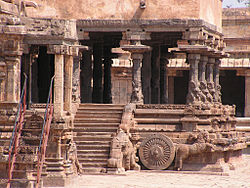Darasuram
|
Darasuram தாராசுரம் |
|
|---|---|
| town | |

Airavateshwarar temple
|
|
| Location in Tamil Nadu, India | |
| Coordinates: 10°57′05″N 79°21′22″E / 10.951483°N 79.356222°ECoordinates: 10°57′05″N 79°21′22″E / 10.951483°N 79.356222°E | |
| Country |
|
| State | Tamil Nadu |
| District | Thanjavur |
| Population (2001) | |
| • Total | 13,027 |
| Languages | |
| • Official | Tamil |
| Time zone | IST (UTC+5:30) |
Darasuram or Dharasuram is a panchayat town located 3 kilometres from Kumbakonam in Thanjavur District, Tamil Nadu, India. According to the 2001 census, the town had a population of 13,027. The town is known for the Airavateswara temple constructed by the Rajaraja Chola II in the 12th century AD. The temple is a recognised UNESCO World Heritage monument.
As of 2001[update] India census, Darasuram had a population of 13,027. Males constitute 50% of the population and females 50%. Dharasuram has an average literacy rate of 70%, higher than the national average of 59.5%: male literacy is 77% and, female literacy is 63%. In Dharasuram, 11% of the population is under six years of age.
This temple is a storehouse of art and architecture. The vimana is 85 feet high. The front mandapam itself is in the form of a huge chariot drawn by horses. The temple has some exquisite stone carvings.
The main deity's consort Periya Nayaki Amman temple is situated adjacent to Airavateshwarar temple.
The Great Living Chola Temples. (a UNESCO World Heritage Site) at Thanjavur, Gangaikonda Cholapuram and Darasuram were built by the Cholas between the 10th and 12th centuries CE and have a lot of similarities.
The legend is that Airavata, the white elephant of Indra, worshipped Lord Siva in this temple; so did also the King of Death, Yama. Tradition has it that the presiding deity Airavateswarar cured Yama himself (the God of Death) who was suffering under a Rishi's curse from a burning sensation all over the body. Yama took a bath in the sacred tank and was rid of the burning sensation. Since then the tank is known as Yamateertham. It gets its supply of fresh water from the river Kaveri and is 228 feet in width. Pilgrims make a point to bathe in the tank. In the recent past Raja Raja Chola worshipped the Siva Lingam in this temple. Volume II of the South Indian Temple Inscriptions deals with a number of endowments of the Pandya Kings also (see pages 556 to 562). On the temple walls these inscriptions are given, from which it is seen that the temple was known in those days as Raja Rajeswararen and Raja Rajapuram. Two such inscriptions are copied here.
...
Wikipedia


